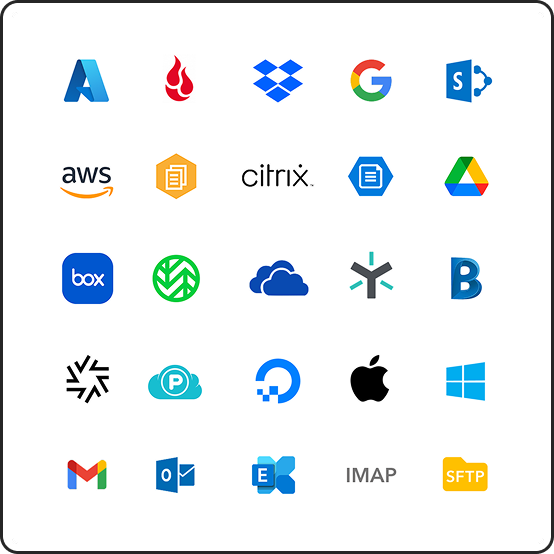Moving data within a SharePoint tenant should be straightforward since there aren't any platform incompatibilities, gathering of credentials, or other common concerns like when migrating between different cloud storage platforms. Unfortunately, this isn't the case. While there are several ways to move the data, knowing it's been done correctly and is in the right state is a challenge. This is one place where Movebot shines, making SharePoint migrations within the same tenant fast and simple.

How to Move data in the same tenant
There are a few different ways to move large amounts of data within the same SharePoint tenant. Two common methods are using the native move/copy functions or using a third-party migration tool.
Moving data in SharePoint with native move/copy functions
All major cloud storage platforms have a quick way to select files and folders in bulk, and SharePoint is no different. So why not simply use the native move/copy functions and call it good? The problem is scale.
Sure, copying/cutting one folder and putting it somewhere else is pretty simple. But what about when you have data across multiple sites and document libraries? Keeping track of everything you need to move is challenging enough, but making sure the move is successful is even harder.
When moving multiple sites with millions of files and terabytes of data, simply copying and pasting gets overwhelming fast. Speed is also a problem at this scale. Since the native move/copy functions aren't a dedicated migration tool, they aren't designed to move large amounts of data and will take longer to move at scale, with a higher chance of failures.
Microsoft has some other caveats about moving or copying files that could potentially be issues in this article called Move or copy files in SharePoint.
Using a third-party migration tool
While Microsoft does have some tools that can assist in migrating data within a SharePoint tenant with some advanced configurations, using a third-party migration tool tends to give the best overall experience. Dedicated data migration tools are designed specifically for moving large amounts of data without losing information, with multiple checks at several points to ensure that files are being moved correctly.
Many third-party migration tools also include comprehensive reporting that will let you know the progress of your migration at any point. Being able to check that your data will move as expected before running the migration is especially important when moving data in the same tenant so it doesn't mess up the existing navigation or structure of your sites.
If you're looking at third-party migration tools because of the speed and peace of mind, make sure to try Movebot, the fastest and easiest data migration tool there is.
Using Movebot to move data within a SharePoint tenant
Movebot is incredibly effective when moving data in a SharePoint tenant. To get the best experience with moving data to SharePoint in Movebot, there are a few best practices you should follow to optimize the process. Doing these optimizations will give faster speeds and a smoother experience for your migrations.
General SharePoint Settings in Movebot
Before you set up a migration, there are a couple of things you should know about connecting SharePoint to Movebot to help make moving data easier. One is to make sure you connect with an account that has the right access levels. Connecting with a Microsoft Admin account on its own isn't enough--the account will also need specific permissions. Basically what you need is an Admin account that can access SharePoint and all the related sites. Make sure the Admin account has the following:
- The Admin user must be licensed for SharePoint
- The Admin user must be either a Global admin or a SharePoint admin
- The Admin user needs to have permissions on any Sites you want to migrate
Having an Admin account with the required permissions will ensure that you can move data at will.
Connecting SharePoint to Movebot
Before running a migration, you'll need to connect the SharePoint account to Movebot. First, go to Movebot and add your connection. Name the connection and choose Sharepoint/Onedrive as the Connection Type.
When configuring your connection, make sure to follow the domain structure to avoid errors, and remember to connect as an admin user with the permissions mentioned above. You'll need to make an application within Azure, and then provide Movebot with the Tenant Domain and Application Client ID & Application Client Secret. If you are unsure about how to do this, follow our SharePoint Online connection guide or watch our step-by-step process in the video below.
After connecting through either method, test that Movebot can successfully connect to SharePoint.
Running a discovery scan
After creating your SharePoint connections, you can start building out your project in Movebot. For any SharePoint migration, you'll want to start with a discovery scan after choosing your settings. The discovery scan checks your transfers and makes sure that the data will move over properly. The scan will tell if there are any issues like files with duplicate names and gives easy-to-understand error messages so you can decide if you need to make any changes before running the actual migration.
The scan can also simulate what the data will look like once it's moved. This is especially useful if you plant to apply settings like filename transformation, so you'll know exactly what to expect when running the transfer. Once you're happy with the scan settings, you can go ahead and choose your data to move and start the migration.
Reporting and cutover
After running a transfer, Movebot will generate a post-transfer report that gives you stats about your migration along with information on any files that were unable to be transferred. In these cases, or if users have added more files to the source since the migration, you can run delta migrations to move over just new and newly-modified files. You can run unlimited delta migrations until you have everything you need in the destination SharePoint account, so you don't have to worry about leaving any important data behind.
Running SharePoint Migrations in Movebot
There are a few different situations where you might want to move data within SharePoint. Some typical Sharepoint transfers within a tenant include moving data within the same site and tenant to reorganize data and migrating one SharePoint site to another site. Fortunately, Movebot can handle each of these situations with ease.
How to reorganize data in SharePoint with Movebot
Over time, data in organizations tends to get cluttered and sprawling, no matter how detailed and intricate the data architecture plan is. Users make shortcuts, duplicate files, or temporarily stick a file in a folder for a single use and never touch it again. These kinds of little things add up, with sources suggesting that a hefty chunk of data in a typical organization are duplicates or other useless files.
There are a lot of benefits to organizing and cleaning up data. First is that files are simply easier to find. Another is wasting space, which can lead to unnecessary storage costs over time.
One more major reason for organizing data is to improve results for Copilot for Microsoft 365 and its AI capabilities. The cleaner and better organized the data, the better Copilot will work, which can help increase efficiency throughout the organization.
Movebot can help with this reorganization in a few different ways. One is by using filtering and exclusion/inclusion rules with a transfer project. With this method, you can isolate files you want or don't want--like files that haven't been modified for the last 6 or 7 years--to only move the files you actually need. From there, you can move the other files that don't meet the criteria elsewhere, or even delete them if you no longer need them in the original location.
How to migrate one SharePoint site to another site
One of the most common SharePoint migrations we see is users wanting to move some data in one SharePoint site to another site in the same tenant. When you connect to Movebot with an account that has permissions on both sites, doing a site to site migration is simple.
As part of setting up a transfer project, you may have noticed that you can choose from multiple sites at once as your source. Essentially, this means you can migrate data from multiple sites at once into a single site. Movebot will create a separate job for each site transfer, which you can run simultaneously if you wish.
With Movebot, you can also specify a document library. This means you can move files between document libraries in the same site at scale, or choose a specific document library in a different site.
How to migrate SharePoint from one tenant to another
Movebot can move data within one SharePoint tenant, but it can also move data between different SharePoint tenants.
Moving between tenants works similarly to migrating between SharePoint sites in the same tenant, only the connections will be for separate SharePoint accounts. Simply choose the site(s) you want to migrate as the source, then where you want them as the destination. To keep the sites at the top level, choose the root as the destination folder.
For more information, see Migrating between SharePoint Tenants, or find out more about other types of SharePoint migrations in The Complete Guide to SharePoint Migrations with Movebot
Move data in SharePoint the easy way with Movebot
Movebot simplifies SharePoint migrations within a tenant with a comprehensive and intuitive interface that just works. By doing some simple setup optimizations and planning out which files you want to move and where you want to move them too, the actual migration is simple.
Want to give it a try for yourself? You can try Movebot with a 50GB free trial with no credit card or demo required. Simply sign up and go and run some tests for yourself. Sign up for your free trial now to get started.






